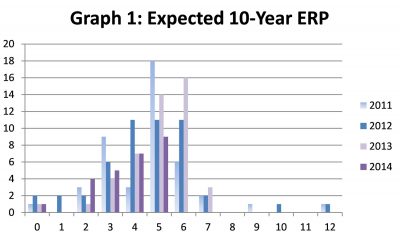
Equity Risk Premium Survey 2014 – Results and Comments
This is the fourth year that the Equity Premium Research group has polled the profession on the size and use of the Equity Risk Premium (ERP). Over this period, the average has ranged from 4.4% p.a. (2014) to 4.8% p.a. (2013).
This year’s survey took place from the fifth to the 14 December 2014. With the survey taking place too close to Christmas the response rate was down on previous years. A total of 29 people participated in the survey, with 27 people providing a response to the question of what ERP including franking credits over the next 10 years would they use for Australian equities. This compared to 46 responses in 2013, 49 responses in 2012, and 45 responses in 2011.
We believe the survey and reported results helps actuaries to participate and identify the topical issues relating the role of the ERP in forecast equity market returns and its range of uses. Surveys of this type can also help identify significant outliers and help create more informed opinions.
In line with last year we define the ERP as ‘the expected excess of the return of the market portfolio of equities over the long-term sovereign bond rate’. As such, the Australian ERP is defined as the expected return on the Australian share market (the S&P ASX 200 Accumulation index is a reasonable proxy) less the 10-year Australian government bond yield. The expected return on the Australian share market includes any benefits assigned to the value of franking credits.

In terms of practice areas, with multiple responses allowed, the respondents were concentrated in the Investments (16) and General Insurance (9) practice areas. There were three respondents who identified themselves with Life insurance and four with Superannuation. Only one respondent identified themselves as working in financial planning. ‘Other’ category respondents included student; M&A transactions; and health.
The range of responses for the Australian ERP was from 0.2% to 6.0%. The mean was 4.4% and the median was 4.6%. This compared to a mean of 4.8% in the 2013 survey; a mean of 4.6% in the 2012 survey and a mean of 4.7% in the 2011 survey. Excluding franking credits (assuming nil value where no response was made) the mean Australian ERP was 3.5% (2013: 4.3%) and the median was 4.0% (2013: 4.2%).
The lowest forecast ERP was 0.2%. The precise nature (three significant figures) of that respondent’s ERP for international and emerging market equities suggests that the low ERP for Australian equities was based on a form of modelling using current valuation metrics. The next lowest ERP was 2.5%. The respondent argued that “The finance industry has a vested interest in vastly over-estimating the ERP, and has done so consistently for the last three decades. Because it is unobservable, these over-estimates can never be proved wrong, so they persist”. Three respondents use an estimated ERP of 3.0%.
On the high side, five people forecast an ERP of 6.0% and the next highest was one person using 5.7%. Typically these high-end respondents included in the ERP a higher than average level of franking credits. The top five high-end respondents included an average of 150bp of franking credits in their ERP, compared to an average of 72bp of franking credit included in the ERP for all other respondents. The mean response for the level of franking credits in the ERP was 87bp (2013: 90bp), with a median of 100bp (2013: 100bp). This was the first year of the survey in which there were not any responses with an expected ERP above 6%.
A total of 22 people responded to question regarding the adjustment to ERP for international equities. Eight respondents make no adjustment. Of the remaining 14 respondents, the median adjustment is a reduction of 50bp (2013: 75bp). The mean adjustment is a reduction of 33bp (2013: 50bp). As was pointed out by some respondents this part of the survey is susceptible to survey data error with regard to the sign of the ‘adjustment’. If all data is assumed to be reductions in ERP the reduction would be 63bp (2013:76bp).
A total of 19 people responded to the adjustment to ERP for emerging market equities. Three respondents make no adjustment. For the remaining 16 respondents, the median adjustment is an increase of 100bp (2013: 75bp). The mean adjustment is an increase of 109bp (2013: 87bp).
Most respondents (64%) said that they had left the ERP unchanged in the past 12 months. Three (12%) said that they had increased the ERP and six (24%) said they have reduced the ERP. One respondent who increased their ERP said it was the result of “Changes in expectations for future volatility (upwards), increasing the market required excess return”.
The most common reason cited for a change in the ERP was changes to prospective economic growth. This was mentioned by five of the six respondents who reduced their ERP forecasts. It was also mentioned by one of the three respondents that had increased their ERP in the past 12 months. Changes in market levels and changes in earnings levels were the other main reasons cited for a change in ERP. One respondent who has reduced their ERP to 4.5% commented “Mine are probably high – the economy is in ruins and the country broke unless commodities rebound.”
One respondent highlighted a paper ‘Equity Risk Premiums (ERP): Determinants, Estimation and Implications’, Damodaran & Aswath, 2013 and said they would be interested in our views of using an implied equity risk premium as compared with historical ERP. The paper prepared by the Equity Risk Premium Research Group for the 2010 Financial Services Forum1 discussed four different ERPs identified by Pablo Fernandez, who runs an annual international survey of the ERP used by practitioners and academics. They are historic, expected, required (by investors) and implied (from market prices). The paper emphasised the need to use judgment in choosing appropriate rates. We encourage further discussion on this issue. One reason we include in the survey a section on amount and reasons for changes in ERP over the past 12-months is that we want to encourage discussion on the issue of how the ERP should change depending on market conditions. If the equity market has risen sharply in the previous year should it mean that the expected ERP should decline? Similarly if the equity market is unchanged but economic conditions, company earnings and/or company dividends have deteriorated, should the ERP also decline?
One interesting comment came from a student who said “I wish to be constructive in my criticism. Firstly: 1). There is no “risk” in ‘equity risk premium’. Please refer to this as just the ‘equity premium’. 2). Please read Richard Fitzherbert’s articles and texts to discover why the distinction in point (1) is important. 3). Please urge the London Institute to improve the rigorousness of CT7 (the macroeconomics part) as the information on the money supply and inflation is out of date. Please see recent publications by the Bank of England. 4). Understanding of point (3) will help you to understand point (1). Thank you for considering these improvements to the education of our profession.”
In last year’s ERP Survey report we pointed readers towards Richard Fitzherbert’s paper A Review of the Methodology of Forecasting Long-term Equity Returns, for the 2007 Actuarial Biennial Convention for a discussion on the topic of the ‘risk’ in the ERP. We also made the point that for the survey our definition of the ERP is the expected excess return of the equity market over the sovereign bond rate. Therefore it does not require the respondent to assume that the ERP is a ‘risk premium’.
This issue was also commented on by the Equity Risk Premium Research Group in its 2010 paper when it argued “Fitzherbert (2004) created a local controversy by arguing that the equity risk premium is caused by the level of return on shareholder equity relative to interest rates rather than a consequence of the risk averse behaviour of investors. While the returns on shareholder funds obviously drive the return to equity investments, we are happy to make the assumption that company managements and the capital markets are at least partly successful in evaluating the likely risks and returns in investing their limited capital, and that there is a trade-off between expected risk and return.”
With regard to the respondent’s comments on publications about money supply from the Bank of England we assume the respondent was referencing the paper ‘Money creation in the modern economy’ which was published in the Bank of England’s First Quarterly Bulletin 2014. The paper explains that banks do not act as simple intermediaries and lend money deposited with them. Instead bank deposits are created through the process of commercial banks making loans. The paper also explains how Quantitative Easing is used to increase the amount of money in the economy.
Despite a somewhat gloomy undertone to the responses in the survey, surprisingly there wasn’t any comment with regard to the consequences of the current historic low level of bond yields in most major markets. With the Swiss bond market showing negative interest rates out to the 10-year bond and German interest rates negative out to the 5-year bond, it certainly makes for interesting times. And of course, that’s when you need an actuary!
| TABLE 1: EXPECTED 10-YEAR ERP BY USE | 2012 | 2013 | 2014 | Count |
| Valuation of unlisted assets | 5.5 | 5.3 | 4.7 | 8 |
| Valuation of risky liabilities | 5.2 | 4.7 | 5.5 | 4 |
| Portfolio construction/asset allocation | 4.5 | 4.8 | 4.6 | 11 |
| Own research | 5.2 | 4.7 | 3.7 | 12 |
| Scholarly articles | 4.2 | n/a | 5.0 | 1 |
| Other uses | 4.4 | 5.1 | 5.3 | 4 |
| TOTAL | 4.6 | 4.8 | 4.4 |
1 http://www.actuaries.asn.au/Library/events/FSF/2010/2010_FS_forum_paper_v3.pdf
CPD: Actuaries Institute Members can claim two CPD points for every hour of reading articles on Actuaries Digital.






